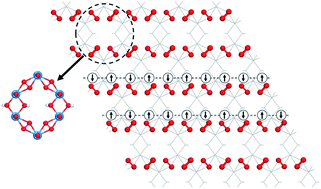Abstract
Versatile graphene-like two-dimensional materials with s-, p- and d-block elements have aroused significant interest because of their extensive applications while there is a lack of such materials with f-block elements. Herein we report a unique one composed of the f-block element moiety of uranyl (UO22+) through a global-minimum structure search. Its geometry is found to be similar to that of graphene with a honeycomb-like hexagonal unit composed of six uranyl ligands, where each uranyl is bridged by two superoxido groups and a pair of hydroxyl ligands. All the uranium and bridging oxygen atoms form an extended planar 2D structure, which shows thermodynamic, kinetic and thermal stabilities due to σ/π bonding as well as electrostatic interactions between ligands. Each superoxido ligand has one unpaired (2pπ*)1 electron and is antiferromagnetically coupled through uranyl bridges with 2pπ*–5fδ–2pπ* superexchange interactions, forming a rare type of one-dimensional Heisenberg chain with p-orbital antiferromagnetism, which might become valuable for application in antiferromagnetic spintronics.

- This article is part of the themed collection: 2022 Chemical Science HOT Article Collection


 Please wait while we load your content...
Please wait while we load your content...